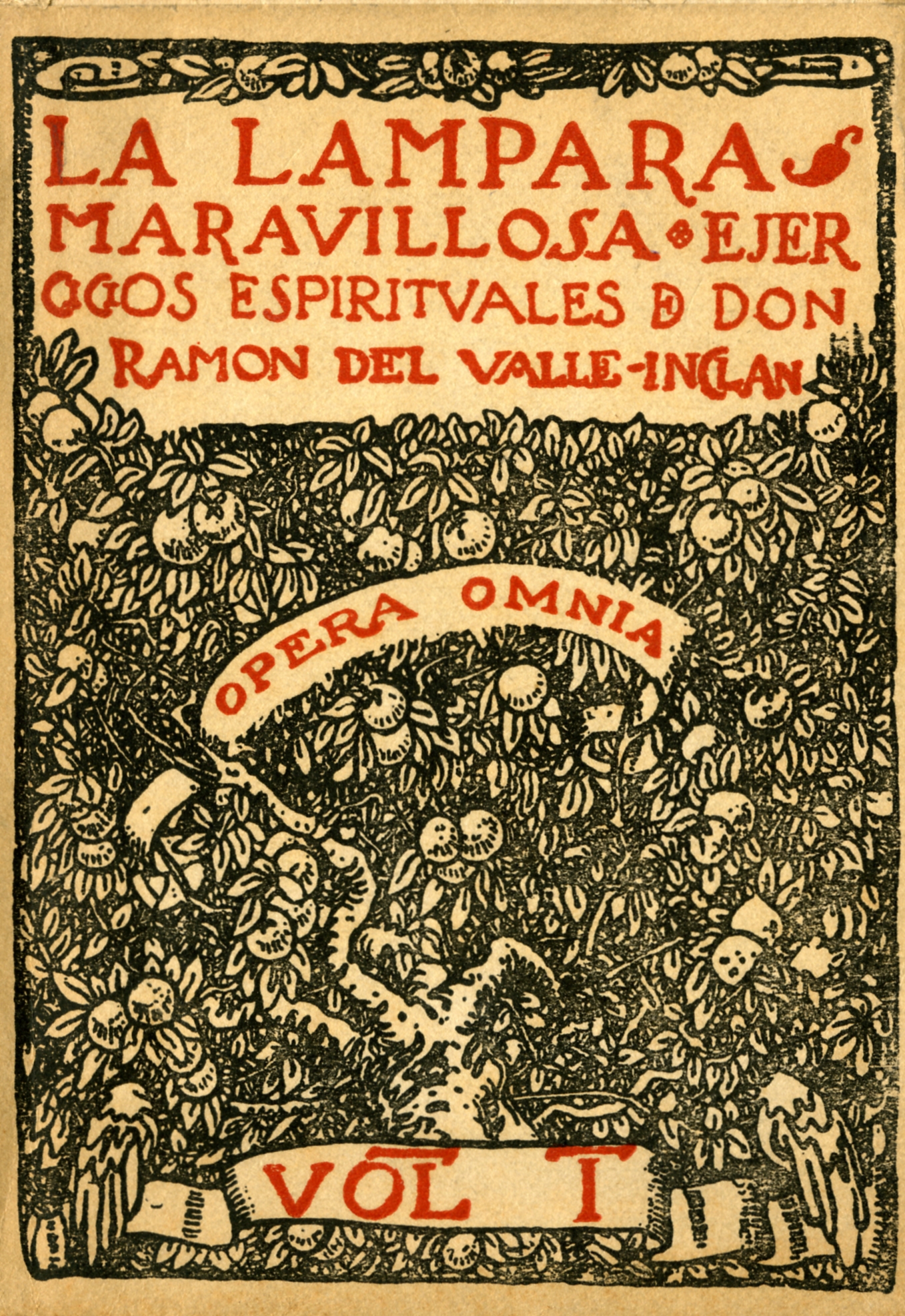
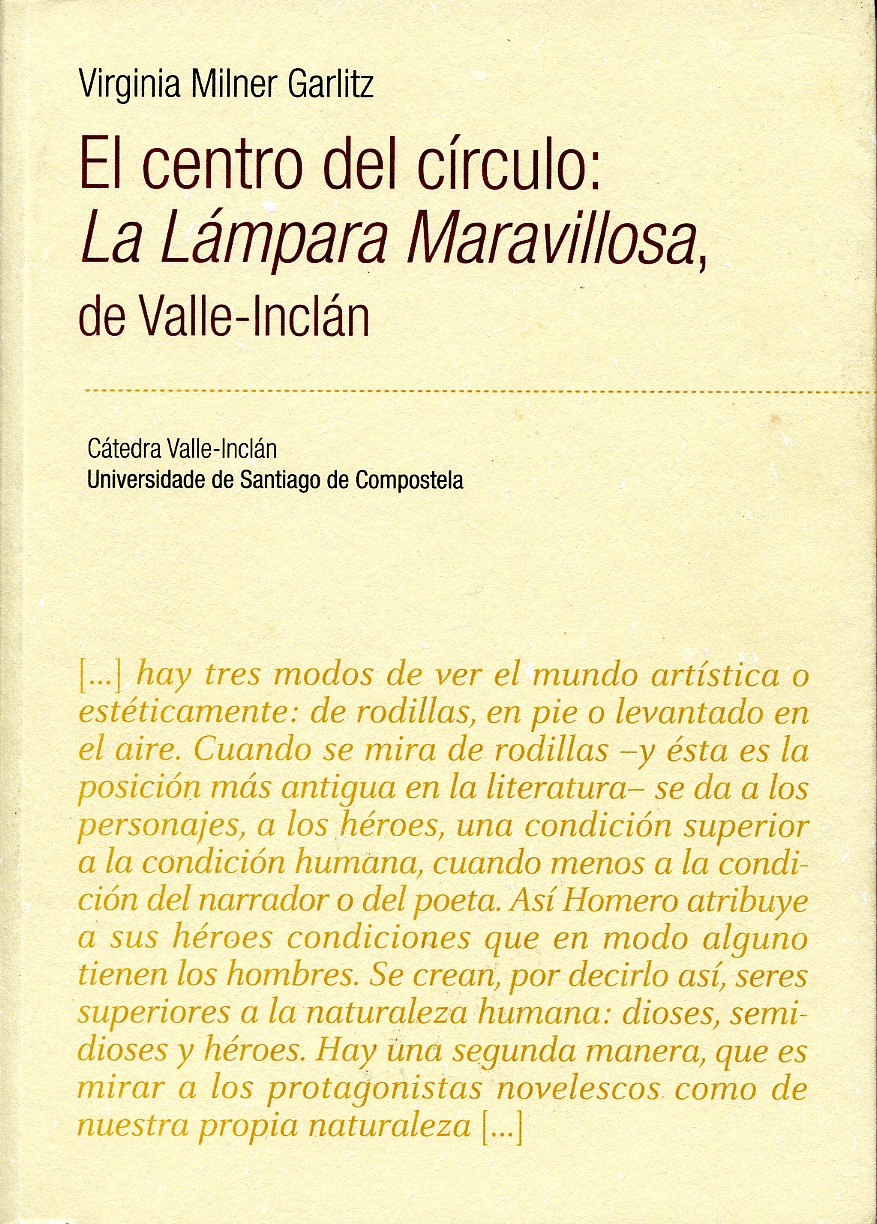 The occultist theories that Valle calls the
foundation of his aesthetics in La lámpara maravillosa2 are
part of the Secret Tradition reintroduced into 19th century
and turn-of -the-century Europe by revival movements such as
spiritism and theosophy. I call this finisecular
occultism to distinguish it from another current of occultism
also important in Valle-Inclán, based on folkloric sources
(see Speratti-Piñero, El
ocultismo).
The occultist theories that Valle calls the
foundation of his aesthetics in La lámpara maravillosa2 are
part of the Secret Tradition reintroduced into 19th century
and turn-of -the-century Europe by revival movements such as
spiritism and theosophy. I call this finisecular
occultism to distinguish it from another current of occultism
also important in Valle-Inclán, based on folkloric sources
(see Speratti-Piñero, El
ocultismo).
According to the French magus, Eliphas Lévi (1810-1875), who coined the word "occultism", its basic principles are as follows: there exists an analogy and an equilibrium between the visible and the invisible worlds. These two worlds are connected by a cosmic medium called the Astral Light. Through contact with the Astral Light, which facilitates all magical operations, the occultist is able to perceive the analogy and control the equilibrium between the two worlds. Occultism is then, a method which permits the transcendence of the phenomenological world and the attainment of knowledge and control of the reality beyond (see Garlitz, El centro, thesis).
Astral Light is seen as a circle which reunites the universal opposites and is frequently represented by the alchemical serpent Ouroborus which bites its own tail.
The mission of the occultist is traditionally described as centering within the circle of Astral Light. Centering within the circle is the theme of LLM; the principle of its structure; the basis of the imagery of the text and of the illustrations of Moya del Pino (see Garlitz, «Las ilustraciones») as well as the key to concepts which illuminate not only this one work, but, as I and others maintain (see Garlitz «Humo y luz» and Verity Smith), all of the literary production of Valle-Inclán (see Garlitz, El centro, book and thesis).
It is therefore important that we come to a better understanding of finisecular occultism in Valle-Inclán.
Elsewhere I have studied various facets of finisecular occultism such as Valle's debt to the most important French occultists (see Garlitz, «L'influence») and his association with leading Spanish theosophists, Mario Roso de Luna and Rafael Urbano (see Garlitz, «El concepto»). Here I would like to summarize some of my findings on finisecular occultism in Spain, especially in Galicia (see Garlitz, «La conexión gallega» for complete data).
I will focus first on the year 1888. In that year Valle, then a student at the University of Santiago de Compostela, published the first story that we know by him which already shows his interest in the occult and its relation to literature. The main character in the story is named Babel because of the "pepitoria" or stew of languages he concocts due to his previous incarnations. Although treated with the satirical tone which befits the magazine Café con gotas (see facsimile of the Grupo Valle Inclán) in which it was published, we have here the beginning of the connection between language and collective memory made possible by reincarnation that will play an essential role in LLM and in Valle's later works.
Reincarnation was one of the concepts that the Spanish spiritists took from the leader of French spiritism, Alán Kardec.(1804-1869) (Garlitz, El centro). By 1888 spiritism, first introduced in Spain in 1875, (Méndez-Bejarano) had weathered the Restoration's attempt to silence it and showed its vitality by holding the first international spiritist conference in Barcelona.
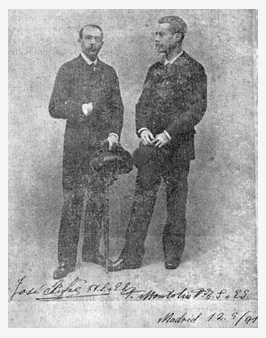
That same year, also in Barcelona, another occultist movement was beginning which would eventually eclipse spiritism, that is theosophy. Francisco de Montolíu y Togores, a young agronomist, the eldest son of an aristocratic Barcelonan family, wrote to Helena Blavatsky in 1875 asking to become a member of the Isis branch of the Theosophical Society which she had founded in Paris3. Mme Blavatsky or HPB, as she was known, put him in contact with another Barcelonan, the wealthy banker, José Xifré y Hamel4 who had met HPB when he was studying in the French capital where he was born. Montolíu, Xifré, and another student of Oriental philosophy, Tomás Doreste, founded the Sociedad Teosófica española in 1889 (see Pomés).
That society would be responsible for the greatest circulation of occultist ideas in Spain through its Biblioteca Orientalista in Barcelona and its journal Sophia, based in Madrid, but that was to come later.
In 1888 the focus of attention was on spiritism and its most interesting phenomenon, hypnosis which was called (animal) magnetism (see Garlitz El centro and Pintar). On January 16th, 1888, the Madrid newspaper El Imparcial published a report on a session in the Royal Palace conducted by one of the most famous practioners of the time, el conde Alberto de Das. Das amazed the royal family by hypnotically "transposing" the senses of his assistant, señorita Mercedes Montero de Espinosa, causing her to find a raw potato sweet, to inhale ammonia as though it were perfume, to receive electric shocks without upset and to walk through a maze of furniture with her eyes closed.
This same conde de Das who was received by the royal family in 1888 was expelled from Spain in 1892 for fraud. This was the pattern that Das was to repeat throughout his career. He triumphed in the capitals of Europe and then in America where he associated with kings and presidents and founded many centers of magnetism, only to leave each place with the police on his heels. Das died in Monaco in 1919.
The article that Roso de Luna wrote on Das in December of 1921 in the Andalusian theosophical magazine Hesperia 5 entitled «Un émulo de Cagliostro», very probably refreshed Valle-Inclán's memory of him, because don Ramón surely had Das in mind when he created Dr. Polaco, an imitator of the "Gran Copte", Cagliostro, in his novel Tirano Banderas in 1923. (see Garlitz, "El teosofismo" and El centro , thesis).
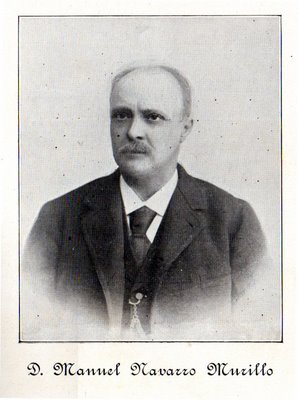
In 1888 in Pontevedra, Manuel Navarro Murillo of the Sociedad Espiritista Española gave a series of four lectures on «Los fenómenos del espiritismo» to the Sociedad del Recreo de Artesanos, the same group to which Valle would present a talk on occultism four years later (see Garlitz, "La conexión"). Navarro called attention to the serious side of spiritism. According to him, and to some "sabios gallegos" whom he prefers not to name, spiritism constitutes the most transcendental fact of modern times because of its consequences for individual and social progress. By means of the perispirit, very similar to Lévi's Astral Light, the living and the dead can communicate with each other. The spirits can thus teach incarnate souls truths of the past and the future. This contact with the spirits explains the miracles of the ancient world and the phenomena of the modern one which materialistic science has been unable to do. Spiritism demonstrates the essential unity of all religions and provides a synthesis of Religion and Science.6
Spiritism provides the key to the ancient mysteries. For example, it allows us to understand what the ancients called gnosis or secret knowledge. The articles on spiritism and gnosticism which Navarro published in the spiritist magazines La irradiación and El criterio espiritista in 1892 and his translation of Jacques Matter's Histoire de gnosticisme (1828) might very well have formed part of the background on this third century religion which Valle was to use as general information in LLM. There, the poet-pilgrim 7 is taught the Gnostic myth of the soul's fall from the timeless world of light or Pleroma into the Kleroma or Satanic world of time, senses and egocentrism.
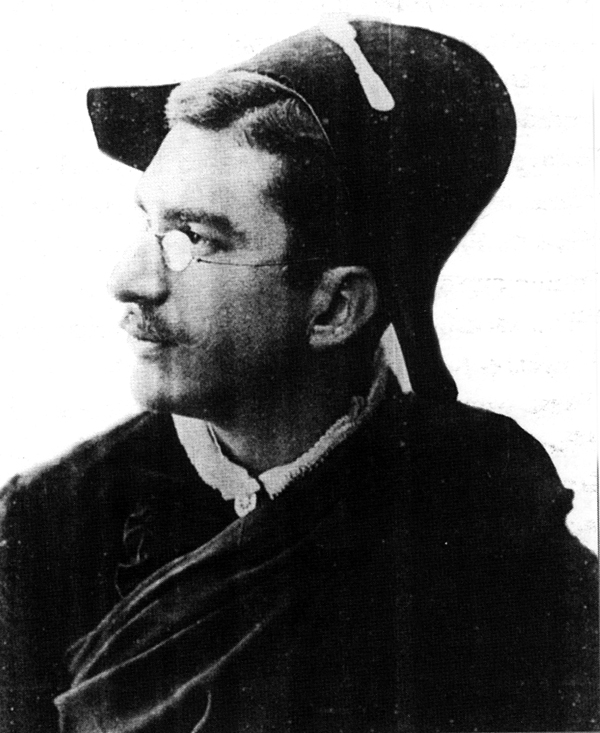 We don't know whether or not Valle attended Navarro's
lectures, but he could have heard others in Santiago either of
the serious or the theatrical kind. At the university during
the 1888-89 term, a professor of surgery, Dr. Timoteo Sánchez
Freire, spoke on the dangers of hypnosis in untrained hands.
One of his students, José Manuel Otero Acevedo was already an
expert in hypnosis. In 1888 Otero was preparing a book
entitled Los espíritus
and he attended the Spiritist Congress in Barcelona
(Méndez-Bejarano). He says that it was there that he convinced
the Neapolitan doctor, César Lombroso, to study spiritist
phenomena seriously, especially those manifested by the
medium, Eusapia Palladino. Otero himself conducted experiments
with her in Naples. He documented all this in his two books Los fantasmas (1891) and
Lombroso y el espiritismo,
published in 1895 by the spiritist journal La Irradiación to which
he was a regular contributor. Los fantasmas caused a sensation in Spain
and was translated into German and Italian.
We don't know whether or not Valle attended Navarro's
lectures, but he could have heard others in Santiago either of
the serious or the theatrical kind. At the university during
the 1888-89 term, a professor of surgery, Dr. Timoteo Sánchez
Freire, spoke on the dangers of hypnosis in untrained hands.
One of his students, José Manuel Otero Acevedo was already an
expert in hypnosis. In 1888 Otero was preparing a book
entitled Los espíritus
and he attended the Spiritist Congress in Barcelona
(Méndez-Bejarano). He says that it was there that he convinced
the Neapolitan doctor, César Lombroso, to study spiritist
phenomena seriously, especially those manifested by the
medium, Eusapia Palladino. Otero himself conducted experiments
with her in Naples. He documented all this in his two books Los fantasmas (1891) and
Lombroso y el espiritismo,
published in 1895 by the spiritist journal La Irradiación to which
he was a regular contributor. Los fantasmas caused a sensation in Spain
and was translated into German and Italian.It was probably at the University of Santiago where Otero became good friends with the young man then known as Ramón Simón del Valle. When Otero finished his studies in Santiago and went to continue for his doctorate in Madrid, he included Valle in two experiments with what he called "visión a distancia"(distanced vision). He placed the medium "S", probably Tomás Sánchez Escribano, (Garlitz,"La conexión") in an hypnotic trance and asked him to go to Santiago to see what his friend Valle was doing. Valle confirmed in two letters that the medium had been correct when he "saw" that Valle had skipped his habitual fencing session to eat with a friend and to play a game of cards at which he lost as usual. Valle said he was ready to go on helping Otero with his "brujerías" or witchcraft activities because, besides being fun, they might help him find out what was going on in a certain "castillo encantado"(enchanted castle).
Valle participated in other experiments with special vision in Navarra with the family of his Carlist friend, Joaquín Argamasilla de la Cerda. )(1870-1940). Valle dedicated the 1916 version of LLM to Argamasilla who was also the godfather of his first son. In LLM, distanced vision, obtained through projection out of the body becomes the aesthetic perspective, distanced from time, space and the senses which Valle calls stellar or astral vision. which he applied to his works La media noche and A la luz del día, based on his experience flying over the trenches of World War I as the correspondent for El Imparcial in 1916, the same year he published LLM. ( see Garlitz, "La estética de Valle Inclán en La media noche")
Borobó s Fantasmas de Valle-Inclán, our main source on Otero Acevedo, says that in Madrid, besides meeting many occultists including Roso de Luna, Otero associated with members of the Generation of 98, especially Pío Baroja. It is perhaps due to Otero that Baroja wrote the 1899 story entitled «Medium», which Valle included in Cara de Dios that he began the same year. The story refers to spiritist photography a special interest of Otero, as seen in his book on Lombroso and his articles in La ilustración española.
In Valle's version of the story, the male medium becomes two women and the storyline of someone being the instrument of an evil spirit forms a strong parallel with the demonic possession of Rosarito in another of the stories written into the text which is a pastiche of the pieces that Valle was working on at the time (see E. Lavaud ). The idea of a medium for contact with either the world of good or evil, is a frequent theme in Valle's work and explains the importance of the two female figures in LLM: la Madrina (Godmother) who initiates the young poet into the transcendent world of light and the blind Costurera (Seamstress) who puts him in contact with the dark forces of the natural world.
Now I will focus on the year 1892. On the 6th of February that year, Valle gave a talk on occultism to the Recreo de Artesanos de Pontevedra. From the review published by La Unión Republicana 8 we can see that Valle talked about occultist phenomena from ancient times to the present. The most interesting themes in the context of the rest of his work are the apparition of ghosts, levitation, and the closely related phenomenon of out of body projection. In the talk, Valle spoke of the appearance of the ghost of Samuel to Paul, and the case, recorded by Cicero, of the patrician who died because he failed to heed the warning of a specter. In LLM an archangel and in El Pasajero, the shade of a dead love, save the Pilgrim/Pasajero from the path of evil ( see Garlitz, «La peregrinación»).
As for levitation and projection, Valle gives, among the examples of Pythagoras, Simon the Magician and Eusapia Palladino, the cases of Abaris9 and the Licenciado Torralba. Abaris's golden arrow, a gift from Apollo, empowers him to see the future, to become invisible and to fly. Licenciado Torralba, while in Valladolid, projects himself to the skies over Rome, from where he witnesses the sacking of the Eternal City.
These examples have in common the idea of projection out of the body and the witnessing of events past, present and future from an aerial perspective. Here is, once again, the seed of stellar vision in LLM.
In his talk, Valle presented as the explanation of the phenomena, the theory of the Italian chemist, Dal Pozzo of radiation or projection of thought, ideas or of astral intelligence. This and many of the other ideas and examples that Valle included in his presentation, can be found in the writings of his friend Otero or in the book mentioned by the Unión Republicana: Isis Unveiled, one of the most influential works by Mme Blavatsky.
He could have taken from Otero's Fantasmas, the names and even the quotations of the important figures of the era (see Garlitz, El centro, book and thesis) and their famous debate with the spiritists about the causes of pychic phenomena. The spiritists maintained the intervention of spirits while the psychists preferred the more scientific explanation of the existence of a kind of psychic force.
The idea of a psychic force which exerts an hypnotic influence which permits communication without words will be a an essential part of the concept of language or the «Milagro musical»(musical miracle) that Valle proposes in LLM. The miracle of how Saint Bernard raised an army for the Crusades speaking to a people who didn't understand his language, and the idea that the music of the French revolutionary song, "La Carmañola", can bring about the Russian revolution are clearly based on what Dal Pozzo called projection which was carefully outlined in Otero's Fantasmas. The fact that Valle attributes to himself Otero's experiments with Palladino in Naples might exemplify his process of assimilation and integration of material.
There probably were other sources for Valle's interest in and knowledge of finisecular occultism in Pontevedra before he left for university in Santiago, probably those of the "sabios" to whom Navarro referred, but thus far, the data I have found comes mainly from the period when Valle had returned from Mexico to Pontevedra. The library of Muruais, so important in his literary development (see J. M. Lavaud), has only one title connected with esoteric themes, that is the catalogue of the Salon des Rose Croix of Péladan for 1892.
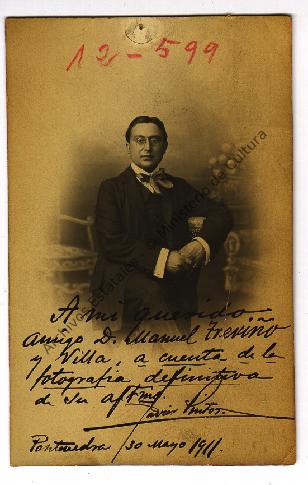 According to Filgueira
Valverde,10 the library which
informed the occultist interests of Valle-Inclán was that of
Javier Pintos Fonseca. Pintos
was about the same age as Valle and they had been friends and
neighbors since childhood. Pintos had in common with Valle an
innate sense of taste and a strong satirical streak. His two
passions were music and occultism. He admired Wagner, but he
idolized Beethoven. Pintos played the harmonium well and was
the moving force behind the Philharmonic Society of
Pontevedra. He was able to combine his two interests in an
edition of Roso de Luna's Beethoven teósofo. Pintos read widely and
his library contained much esoterica.
According to Filgueira
Valverde,10 the library which
informed the occultist interests of Valle-Inclán was that of
Javier Pintos Fonseca. Pintos
was about the same age as Valle and they had been friends and
neighbors since childhood. Pintos had in common with Valle an
innate sense of taste and a strong satirical streak. His two
passions were music and occultism. He admired Wagner, but he
idolized Beethoven. Pintos played the harmonium well and was
the moving force behind the Philharmonic Society of
Pontevedra. He was able to combine his two interests in an
edition of Roso de Luna's Beethoven teósofo. Pintos read widely and
his library contained much esoterica.Pintos' library has unfortunately disappeared. However there is another library of another friend of Valle's, that shows us some of the titles in circulation, that is the collection of Víctor Said Armesto. The library, though small, since Said died at 42, is intact and thanks to Said's custom of underlining and commenting on almost everything he read, we can get a good idea of what a cultured, well-educated intellectual read and thought at the time. Said and Valle were friends throughout Said's life and they coincided not only in Pontevedra but also in Santiago and Madrid. There is a good chance that occultist subjects were among the many they discussed.
The occultist books in Said Armesto's library fall into three categories: Freemasonery, spiritism and theosophy.
Among the books on spiritism, which include as one would expect, the works by Otero Acevedo, there are six issues of La irradiación of 1894. Aymerich, the pseudonym of Alfredo Rodríguez de Aldao, links them all. Rodríguez appears to have been the first owner of Said's copies of Fantasmas and Lombroso because they bear his seal which names him "Profesor en magnetismo e hipnotismo". Five of the issues of La irradiación contain articles by Aymerich arguing in favor of spiritism and opposed to modern theosophy which he finds lacking in originality and intellectual rigor.
Rodríguez was part of the family whose coat of arms can be found in the cloister of Santo Domingo, now part of the Museo de Pontevedra, which houses Said's library. He appears to have been a cousin of Said Armesto. Rodríguez was active in occultist circles in Pontevedra in the summer and in Madrid the rest of the year.
Under the pseudonym of Enediah Shaiah, Rodríguez de Aldao published a version of El libro magno de San Cipriano (1892), a work that Valle mentions often, especially in its connection with the discovery of buried treasure.11 Shaiah also wrote El hipnotismo prodigioso which contains photos of impressions made on clay by spirits. Valle mentions such photos in his 1892 talk. Rodríquez Aldao dedicated his Hipnotismo prodigioso to Pintos Fonseca. Pintos claimed that Aldao had convinced him to join the Theosophical Society. Apparently Rodríquez had joined the same Society that he had refuted in 1894. He seems to have been Said Armesto's guide in the theosophical area as well. Said owned the principle books of the most important Theosophists and some of the earliest Spanish translations of works by Annie Besant, Blavatsky's successor, Sinnett and the main works of Blavatsky, Isis Unveiled and the Secret Doctrine.
Rodríguez Aldao was the link between Pontevedra and Madrid. He was a friend of Manuel Treviño y Villa, the national secretary of the Spanish Theosophical Society for many years. Treviño dedicated his life to the Society and remained faithful even after the schism caused when Besant declared Krishnamurti to be the new Messiah.12 In the 1930s Treviño was denounced by his son-in law and executed by Franco's police.(Pomés) Today his confiscated papers form the Theosophical Section of the Historical Archive of Salamanca.
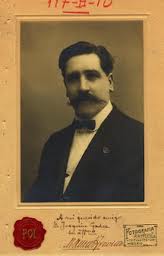 Treviño put Aldao and Pintos Fonseca in touch with another
Pontevedran occultist, Jacobo San Martín Lozano. San Martín
joined the Theosophical Society in1902 and published several
items in Sophia. Rodríguez
Aldao, Pintos Fonseca and San Martín founded the Pontevedra branch of the Theosophical
Society "Marco Aurelio"
on August 16, 1911. Treviño, who
was then the director of Sophia dedicated much
space and a photo to the new group. In the article
signed by "A", very probably Rodríguez Aldao, the description
of "Marco Aurelio" reveals its Modernist affinities. In order to harmonize
truth with the beauties of tradition and art, the group
decided to meet in the ruined cloister of Santo Domingo next
to the arch with the Aldao coat of arms. According to
Rodríguez, it is not possible to look at this superb jewel of
Gothic art without feeling «esa pura emoción estética que hace
perdurar en nuestra mente el recuerdo de tales maravillas, en
aquel lugar saturado por las preces de los hombres que en
tiempos de profunda fe sentían en sus almas su intenso amor a
lo divino.» ("that pure aesthetic emotion which perpetuates in our minds the memory of such
marvels in that place saturated with the supplications that
men of profound faith felt with their intense love of the
divine.").
Treviño put Aldao and Pintos Fonseca in touch with another
Pontevedran occultist, Jacobo San Martín Lozano. San Martín
joined the Theosophical Society in1902 and published several
items in Sophia. Rodríguez
Aldao, Pintos Fonseca and San Martín founded the Pontevedra branch of the Theosophical
Society "Marco Aurelio"
on August 16, 1911. Treviño, who
was then the director of Sophia dedicated much
space and a photo to the new group. In the article
signed by "A", very probably Rodríguez Aldao, the description
of "Marco Aurelio" reveals its Modernist affinities. In order to harmonize
truth with the beauties of tradition and art, the group
decided to meet in the ruined cloister of Santo Domingo next
to the arch with the Aldao coat of arms. According to
Rodríguez, it is not possible to look at this superb jewel of
Gothic art without feeling «esa pura emoción estética que hace
perdurar en nuestra mente el recuerdo de tales maravillas, en
aquel lugar saturado por las preces de los hombres que en
tiempos de profunda fe sentían en sus almas su intenso amor a
lo divino.» ("that pure aesthetic emotion which perpetuates in our minds the memory of such
marvels in that place saturated with the supplications that
men of profound faith felt with their intense love of the
divine.").The aesthetic emotion induced by the contemplation of a medieval work of art that puts us in contact with the magnetic current of collective memory could describe the ecstatic experiences of the Poet-Pilgrim in LLM caused by his contemplation of the Salnés river valley and the stained glass windows of the Cathedral of León.
The members of "Marco Aurelio" were greatly disturbed by what they considered to be the religious fanaticism of Annie Besant and demitted en masse from the Theosophical Society during the schism of 1913. However they continued as an independent group with Roso de Luna as honorary president. In addition to the edition of his work, the group published La iniciación de Osmay by Jacobo San Martín. As in all his writings for Sophia, San Martín's story deals with theme of karma. Osmay travels to the island of Ceylon which the theosophists consider to be the birthplace of all esoteric knowledge, to study at the feet of the old master, Dasa Gama. Osmay learns that nothing happens by chance. The world follows the law of karma according to which the actions of one life are punished or rewarded in succeeding incarnations.
The idea of karma is very important in LLM. There the Poet-Pilgrim projects himself into the Astral Plane where he is able to see his past lives recorded in the mirror of Astral Light. Since past lives govern future ones, he fears that he, like Julian the Apostate, by failing to center his life on eternal love, may have condemned himself to a never ending cycle of suffering. His individual karma also has repercussions for his people. If he is successful in creating a language based on his vision of the authentic identity of Spain, rather than producing a ridiculous babel as does the character in Valle's first story, he might bring about the miraculous harmony of the old and the new and take his rightful place at the center of the Spanish people, that is become the lamp of karma that illuminates Spain's true destiny.
In Valle-Inclán's first esperpento, Luces de Bohemia, the astral light of the marvelous lamp is reduced to the bleary lights of the bohemian world, which illuminate not an ascent to an idealized Galicia projected out of time, but a descent into the inferno of contemporary Madrid. There the blind poet-pilgrim Max Estrella arrives at a vision which confirms the poet-pilgrim of LLM's fears. The place of the poet at the center of his people's destiny has been usurped by don Filiberto, a degraded version of Roso de Luna who, instead of controlling destiny, simply records the next cycle of corruption to which the inhabitants of the inferno have condemned themselves. This is the same vision that Lupita la Romántica has in the hypnotic trance induced by Dr Polaco, Valle's version of el conde de Das in the novel Tirano Banderas. In spite of his chicanery, Lupita sees the destiny of a world in which revolution does not break the chains of tyranny, but rather strengthens them in incessant cycles. This is the same vision that Valle reveals in his unfinished trilogy of Ruedo ibérico.
When the Second Republic seemed to offer new hope for Spain, as Dru Douherty shows us in La Segunda República, Valle had a very clear idea of what his role was to be. We recognize his familiar themes when don Ramón affirms that his knowledge of Spanish history and his writer's vision empower him to serve as a seer for the new nation. From his perspective, distanced from politics, but close to the collective soul of the people, he can help to direct the new Spain to its true destiny.
We can say then, that the occultist ideas in Valle-Inclán's work are not just a reflection of a passing fashion, but rather serve as the foundation of his aesthetics and as a key to his personal vision.
© Virginia Milner Garlitz